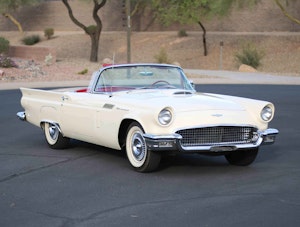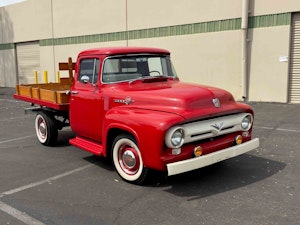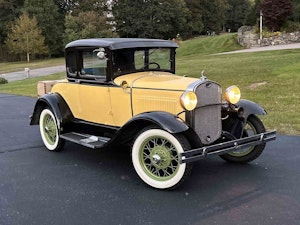Media | Articles
When Does a Car’s Story Matter?
I have a confession to make: I’m a sucker for car stories. Almost every car has one. Some are happy, and some are sad. A few are delightful, and others are truly tragic. Stories add an element of humanity to this little hobby of ours, and enrich it in the process. Just like fine wine and stories about your high school football exploits, though, car stories seem to “improve” with age. And by “improve” I mean get a bit further from the actual event or events. In my experience as an appraiser and a car guy, that can be a problem.
Here is one simple example of how this automotive “story inflation” happens quite innocently. In this case, the names of both the car and the celebrities have been changed to protect the innocent …
The seller of a 1970 Mach 1 Mustang mentions in passing that the car he is selling was once owned by a roadie for a famous rock group, The Stray Pets. He enjoyed the car and took members of this famous band out from beer runs or airport drop-offs. You get the picture. No ownership by the band or its members, but rather from someone associated with the group.

The buyer enjoyed the car for a few years and, when it’s time to sell, that owner tells the next owner that the original owner was a member of the famous rock group. In other words, he has not only passed along hearsay information, but has also improved upon it. By the time the car has passed on to the next seller, lead singer (and famous heartthrob, of course) Bob Rockstar of the Stray Pets was the original owner, who bought it new in Hollywood after their first album went platinum.
Next time the car is seen, it’s at an auction with a full-sized cutout of Bob Rockstar, along with a signed copy of the famous first platinum Stray Pets album.
If you are thinking of buying Bob Rockstar’s car, here are a few things you can do. First and foremost, don’t overpay because of an unverified story. Ever. The second thing that you can do, if that story is just too enticing, is try to verify it.
Marketplace
Buy and sell classics with confidence
Here is where some good detective work can come in handy. This is all stuff that you can do yourself, if you are so inclined. First, does the build date of the Mach 1 line up with any of the events that is was supposed to be a part of? I’ve found that this can be the easiest way to confirm or deny the story. From there, if you find that the Mach 1 existed in the possible timeline, then start asking more questions: Did the Stray Pets even exist in 1971? A quick search might give you an answer, but even that could be nuanced. Maybe the Stray Pets were together, but that was before Bob Rockstar was the lead singer, for example. Does the timeline of their first Platinum album match with the year of the car? Again, this is likely an easy one to answer. In other words, look for red flags and don’t ignore them. Now might also be a good time to search both for magazine and newspaper articles and photos of and about the Stray Pets. One question will lead to the next.
I’m never surprised when we find out how far off the possible timeline these imagined stories often are. In many cases I have seen, the timeline is your best friend, as the events described which might have been plausible just fall apart when the car itself didn’t exist until a later date.
I get that sometimes these story inflation problems start from an innocent mistake, just the conflation or misremembering of events and people over the years. Unfortunately, in some cases an owner will just make something up and convince themselves that their truth is the actual truth. This is where good old common sense come into play.
The issue of stories doesn’t just crop up in the case of famous previous owners. They make a difference in the makeup of the cars themselves, especially when they explain an unusual combination of equipment and/or options. Again, common sense should be front of mind. For example, did General Motors stop the production line to make one Vega with fake Leopard skin seats, like someone told you they did? No, they didn’t. Somewhere an owner did that, but not GM. Did Ford take a 1967 Mustang off the production line to put a GM Crate Motor in it? Nope, not going to happen. And if they did, to use it as a test bed, then the car and motor would have been destroyed, not sold. Most claims about a car’s components and history can be verified with enough research and/or consulting with experts.

For smaller companies, though, those that built cars in the hundreds per year, the rules could be a bit different. I visited Avanti Motors in South Bend, IN, numerous times in the late 1970s through 1985, and I can attest that a few cars were built with customized touches like real Marble dash inserts, questionable fabric and color interior combinations, full custom sound systems and, in one case, a blue and yellow paint scheme for a very enthusiastic University of Michigan supporter.
The same can hold true for many smaller European manufactures, as a wealthy clients who were repeat customers may have been able to special order colors, accessories or equipment to their specification. Today, many of the smaller manufacturers and a few of the larger ones also offer clients their form of “bespoke” customizing options. Cadillac will even let you custom design your new electric Celestiq, provided you’re planning to drop $300,000 on yours. All of the above are things you should be able to verify. If you can’t, well, it simply isn’t enough to rely on word of mouth or hearsay.
Stories about cars are great, but in the end they are mostly just that—stories.














Another opposite story. Back in the 70s a neighbor bought a Mini Cooper from a private party to restore. No story came with it. But when we took out the seats, there was some sort of paperwork with Peter Sellers name on it stuffed in the springs. That became his car story.
I purchased a “movie” car at an auction. From there the research began. Copies of titles, interviews, and a trail of custody, led me to a verified story. Three others questions arise. Was the movie important enough to make it more valuable? Do all of the changes to the car since the movie, affects the value? And finally, what is the adjusted value?
Most people do not care if a previous owner was a celebrity, unless it was someone who actually knows about cars like Jay Leno. I once saw an advertisement for a Mercury Grand Marquis that had been owned by Aaron Hernandez while he was in college. My reaction was to roll my eyes.
Never heard of Aaron Hernandez
Solid proof for celebrity ownership should be well documented on paper…. like my 1963 Avanti owned by James E. Myers, author of the song made famous by Bill Haley, “Rock Around the Clock”. I made sure to copy the original Pennsylvania title made out to him with his signature on the back when he sold the car (after a tragic accident into a tree). He was not driving the car….he let a friend use the car.
Regarding “special factory orders”…even the big manufacturers do that…Used to be you could order a car and choose from a long list of RPOs (regular production options) and even a few special ones. Not any more; they’re bundled, and with a few exceptions, you’re offered what the factory wants to build, not (necessarily) what you want.
* As late as 1985, you could order any Buick in any color offered by Buick that year, even if it wasn’t offered on the particular model you were buying. IIRC it was a $72 option.
* My friend’s ’53 Studebaker Starliner hardtop is painted a very attractive dark blue with a cream top. The interior is bright red vinyl. He has the original factory build sheet showing it was ordered that way. We think it was a special order, as it was sold new to a local doctor for his wife.
* Another friend bought a 55 Cadillac Fleetwood, equipped with every non-conflicting factory option: the dual 4 barrel Eldorado engine, air conditioning, deluxe radio etc etc. It was painted all white, when Fleetwoods were all two-toned from the factory. The build plate was W coded, meaning it was a special order. It also had the featured interior for 1955: Pacific Coral leather and white brocade. We joked it must have been ordered by some town’s pimp… Never seen that interior on a Fleetwood, however, my folks had a 55 Fleetwood that was painted Pacific coral/white–but with a very drab grey/brown broadcloth interior. Never seen that exterior on a Fleetwood either; Coupe de Villes and convertibles, but not Fleetwoods.
I worked for a Chevy dealer in the 60’s and we had a bright blue Impala 2 door hardtop with a white vinyl roof and bright red seats. Patriotic, no? It was mistake on the order form and took forever to sell.
My 1965 Sunbeam Alpine was once parked at Denny Mclain’s house, right next to his 1968 Thunderbird (License DM 3106) in Beverly Hills, MI.
Perhaps a parallel story…….
I once checked in to a Bungalow by the Ocean at the Kea Lani Fairmont Hotel in Maui, HI. The Concierge person guiding us to our Bungalow made a big deal out of that Mike Tyson had just checked out from the very same Bungalow. I was disgusted and almost wanted to trade for a less attractive site, but after a few minutes I decided to rely on housekeeping having disinfected the place……….Same would be my decision on a car owned by Celebs like this. They are usually careless and treat owned/Leased and rented items as disposable……
An old friend once bought a Porsche 911 Slant Nose once owned by the same celeb. The car was tuned and while it had about 650hp, the car ended up being a piece of junk and cost the new owner a fortune (he did not have) before he finally sold it way below cost………Lesson Learned.
Unusual equipment can be a way to trace a car. MC A of the Beastie Boys had a Ford Crown Vic with an in dash DAT player so he could listen to studio tracks. If you you can find that car, with that head unit, and some corroboration it becomes an interesting artifact, although probably still not worth much
I own a 1975 Olds Cutlass Supreme that my wife and I ordered from the factory in September, 1974. We had a frame off restoration that was completed three years ago, so I now go to many local Cruise Nights.
When people stop to look, I’ll let them know that I’ve owned the car for 50 years, and that my wife and I ordered it from the factory in 1974 – that seems to bring about a higher level of interest. I have a three ring binder with 36 pages of pictures with descriptions of the restoration journey that I place in the engine compartment. They’ll take time to go thru most of, or the entire notebook, and ask questions as they go along. They’ll then take a walk around the car commenting on the beautiful paint – original color GM code 29 – Midnight Blue. Some stick their heads inside the window asking if they can sit in it – swivel bucket seats seem to attract attention.
I really enjoy the interaction between me and the person looking at the car – makes the night a lot more fun. Sometimes I’ll not say anything about the history – that leads to little or no interaction at all – the person just glances at the car, maybe make a comment, then move on. The story is what seems to make the car more interesting. I do get a lot of “my grandfather had one of these”.
Couldn’t care less who owned a car any more than I care if a Chevy has ‘SS’ emblems on it. It all just jacks the price.
I look forward to telling a story in the future for which I’m carefully building the details for my progeny now. In particular, the ’47 Dodge WD-15 pickup truck my father-in-law sold to me before he passed away. It was purchased new by a plumber in New Haven, CT, coming out of WWII, who had it tricked out for his business. You can still read the faded hand-letters of his name and “New England Plumbing” on the door, plus the phone number on the tailgate (where the first 2 digits are actually letters…that’s how you remembered phone numbers back then. “UN” stood for UNiversity as Yale is prominent in the area). Story goes, the plumber died less than 2 years later, with very low miles. The widow sold the truck to the family that owned Griswold Airport in Madison, CT (which is now defunct and converted to a town park and soccer fields in early 2000s.). My father-in-law was a private pilot and used to see the truck parked near his hanger. As the story goes, he bought the truck in the late 1960’s, and enjoyed frequent trips with all the kids in the back (no seat belts) to get ice cream. My wife remembers piling into the truck bed for some adventures as a young child. It was parked in his barn in Cheshire, CT in 1973 with 24,500 miles, and the 1972 dump sticker on the window. It then became home to grateful families of mice and racoons for 48ish years, before my wife and I winched it out (hazmat suits and masks were included), and hauled it to our home and remains a slow project survivor truck. Found his old paystub in the glove compartment. The internet connects me to dedicated fans of these trucks who will help with restoration. The story will go on. If I get hit by a FedEx truck some day, hopefully you will run across this truck on BAT and tell it for me. My wife will be happy to get it moved on to the next storyteller to free up a garage bay. Cheers!
The Stray Pets? Never heard of them.
Bob Rockstar? Never heard of him.
I would simply say…when it’s your story. May not hold much interest to others, but you didn’t buy you vehicle for others, you purchased it for yourself. All the time, enjoyment and memorable experiences will always mean more to than others. But that’s as it should be…
So my 1930 James Bond Bentley, originally owned by Cleopatra, is a fake?
Our story started in late 1979 when we were able to purchase a 1932 Buick Model 56, “Doctor’s Coupe” bought new by Miss Willie Welch of Talladega to fulfill her duties as Alabama’s first state librarian. She drove “Red Mule” 104,000 miles all over the state: “In 1932, Alabama only had 4 paved roads and I avoided them because they were in such bad shape.” Her car was sold to a colleague (who failed to restore it as promised) when she was 65, being placed on state assigned insurance risk because of her age. Alabama mud has so much iron ore in it, there is no incentive to rust.
We became very close to Miss Welch through the years, including a volume of anecdotes, so a decade after the purchase, and with her car restored to Buick Club of America Senior Archival status, it was trailered to Talladega for a reunion. Now in a wheelchair, she was unable to climb into the car for a reacquaintance drive. She however approved of our efforts although “you didn’t get it red enough.” (Grenadier Maroon)